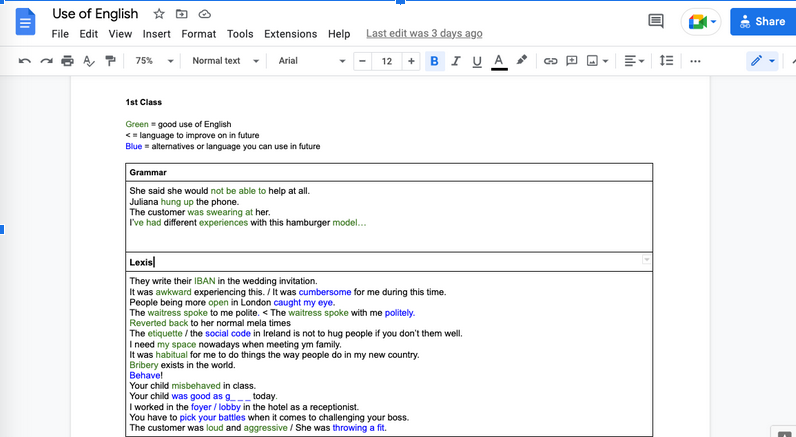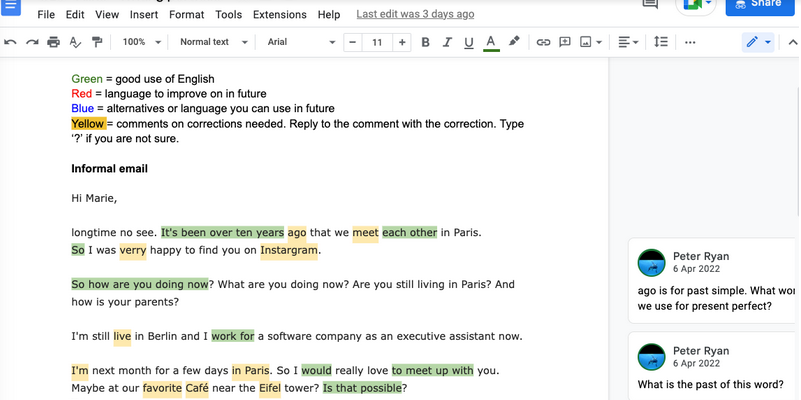Giving feedback is one of the most underrated parts of language teaching, especially when it’s supportive and motivational. Peter Ryan explains how to use positive feedback to propel your students and clients to achieve their learning goals faster and with more fun.
I didn’t use to do feedback very much in my formative years, or didn’t know how to do it, apart from a few throwaway comments here and there: “Good job” and “Well done”. When I did start to give feedback, I would just copy what other teachers were doing: highlighting errors on the board and asking students to correct them at the end of the lesson.
Today, I deliver feedback very differently to how I was taught back then. While completing my Delta, I worked very closely with students and their output, making them feel proud about what they had produced while enjoying the process of listening to or reading their ideas in real-time.
Giving feedback to my students and clients is now an integral part of my lessons, and something I cherish about being a teacher. It is a time when learning is very meaningful for students and a time when progress can be quite tangible.
WHEN to give feedback to students
Knowing when to give feedback to your students is key. Giving feedback at the end of the lesson can be useful as it leaves the students feeling warm and motivated. They are walking out of the lesson knowing their teacher listened to their ideas and helped them in certain areas (or highlighted their strengths).
With this idea of students’ well-being and energy in mind, it’s also good to give feedback directly after a student’s speaking practice as it spurs them on to take more risks during the rest of the lesson. I like to work on fluency at the start of the lesson and as much as possible throughout. After a good chunk of speaking time, feedback takes 4-8 minutes to get through. [The British Council has some great resources – Ed.]
Once they get used to this method, students approach speaking tasks in various, experimental ways: trying to sound natural, focusing on accuracy, extending their ideas, working on active listening, and so on. For these approaches to work, your students need to have a strong task to dive into.
Real-time benefits
Another reason to give feedback directly after they have worked on their output is that the ideas will still be fresh in their memory.
Immediate correction can also be useful mid-speaking, especially when students need your help or if a communication breakdown has occurred. It’s up to you if you want to disrupt their flow of speech to correct a persistent error. I would wait until they have completed their idea, as it may be more memorable to them.
For writing, as well as giving feedback after a completed draft, I like to give students time to write a little before I go and check on them. I check to see if they are practicing the target language (I don’t force it though), adhering to the genre conventions, and making general comments about the content. This helps the students to understand and get more comfortable with the idea that writing is a process.
WHO should give feedback
Culturally speaking, some students will expect their teacher to be the one, and only one, to give feedback. However, there are advantages to getting the students to give feedback to each other once you’ve trained them how to do so. A transferable skill like this is something they may need to practice for the corporate world, for instance, a team-lead giving feedback to their teammates. Students will benefit from practicing to find the strengths and weaknesses in their peers’ work. They will have a fair idea of what to look for if the lesson has a particular aspect of language as a focal point. Students who are particularly good at this will look for things outside of this focus.
Another caveat to teachers giving feedback is that students often don’t believe them, especially when it comes to highlighting their strengths. Hearing feedback from their peers, from multiple angles also, will give them encouragement that their language capabilities are stronger than they think. Everyone can’t be wrong in the class when they have received objective feedback.
It is also worth getting the students to reflect on their own work. This gets the students to think deeply about the thinking or coding process they undertake while they are speaking. Also, the feelings they express enable the teacher to unlock what’s going on in the student’s head. This metacognitive activity can be very enlightening for all involved. Again, it takes time for students to get used to this practice, but being a reflective practitioner is a pretty outstanding skill to have in the business world.
WHAT to feedback to your students
Grammar will be high on the list for students, as well as mistakes. However, there is so much more to focus on: all four language systems – grammar, vocabulary, pronunciation, and discourse – the strengths and areas to work on, and how to change, develop and extend ideas in different ways. I live by these criteria and have noticed slow and steady improvements in my students in terms of output, energy, and motivation.
Grammar
When focusing on grammar, of course, feedback their control of the target language being practiced in the lesson, but also include items of language that have been covered already (or what was covered in previous levels), so it feels as if language isn’t being restricted. It’s up to you to include items of language that you haven’t covered in your courses yet. If you feel the other students would benefit from something a student had said, it could make that student feel incredibly proud of their work. I wouldn’t correct anything the student hasn’t covered yet as that wouldn’t be fair.
One final thing on grammar: I don’t point out to students that an item of language is a typical mistake or a false friend, as some students want to think in their L2. To illustrate an example of this, my German teacher said to me not to confuse ‘man’ in Deutsch with ‘man’ in English. However, I had never made this error and like to approach words as they are in Deutsch. I don’t think, “Oh, that’s an English word”. But, because the teacher had now made it salient to me, I might make this error in the future. My teacher was making generalisations about certain language learners which weren’t true for me. I’d imagine a number of other language learners also approach learning in this way.
Vocabulary
For vocabulary, feedback as much as you can – highlight their strengths and what needs improving, too: highlight rare lexis, word combinations, phrasal verbs used, and so on. Doing so can create a learning opportunity for the other students. They can learn new or recycle old language that their peers are using. This is what I love about my job now: I enjoy listening to my students and showing them what I loved about their ideas. Students are also interested in what their friends had said so I give them this opportunity.
Pronunciation
Pronunciation, which is often out there in the development wilderness, can have its day in the sun if focused properly. Try to feedback strengths and weaknesses in areas such as word stress, pitch movement manipulation, final consonant sounds, and so on. Any pronunciation areas that affect meaning construction will get the students to focus on them at the same level as grammar and vocabulary.
Discourse
Discourse is particularly important for business students. Give them feedback on how well they transition from speaker to listener and vice-versa. How do they react to ideas? How do they build conversations? Do they reference forwards and backwards? Things like this can get the students to think long and hard about their conversations with others. They can also give the students a lot of confidence when navigating these contexts.
Mistakes
While mistakes are important to feedback, so are strengths. Your students need to know that what they are saying is working. Focusing on the positives can energize and propel them forward to work on something new, make them not play it safe, and take risks. Saying to the students, “Your grammar had good control in most parts today, but, here, you said ‘must can do’ when you have to say…’ isn’t fair; what was well-controlled about the grammar? It is better to show them exactly how good their grammar was. This leads us to:
HOW to deliver feedback
Using the board can be great as the students have a record of their work. However, the board only has so much space, and ink can be hard to come by. Besides, if the ink is too faint, if the writing is not big enough for those sitting at the back of the room, or if they strain to see what you have written, they will switch off.
An easy workaround: digital feedback
For all my students and clients, I thus use Google Docs which show them clearly what they have done in each language system, all colour coded.
Green represents good control or rare use of the language. Improvements are shown via a correctional arrow – here I like to show the error beside its correction to make things memorable. Finally, I recast, reformulate or show synonymous utterances in blue.
I use the document as a base for further discussion on their ideas. I might probe them to teach the other students the words they used, think of synonyms, think of formal or informal equivalents to words, think about the connotations of words, and so on.
Students can take this feedback and access it anywhere. They never lose it either as they can hit the ‘last edit’ button at the top to check the document’s history. I always advise students to transfer the language they like into their notebooks that evening to promote revision strategies. This document works well for online classes and one-to-one classes. Of course, it’s also suitable for face-to-face group classes – the students just need to scan the QR code for the document (you can find it in the URL).
Going digital then eliminates all the problems outlined above with regard to board work. Moreover, it allows you to write a lot more feedback and enjoy your job listening to the students’ work in a positive way.
The same goes for writing. I give them an online portfolio to add their entries or work on their drafts. Feedback is similar to speaking but with writing I also add comments to their document to give the students an opportunity to correct their work or just to give them praise when control of the language was particularly good.
Students normally take this feedback into their next draft or new writing which they enter into the same document. Students never lose their work either which can be true with paper.
I hope this article has helped and best of luck with your feedback sessions with your students.
And for some other useful online tools, why not check out our article Go Digital Like the Teaching Pro that You Are! 5 Amazing Online Tools for English Teachers? – Ed.
***












Hi,
This is informative article I like most and I learn many things how to motivate my students I will use them.
Regard
Iram Amjad
Thank you